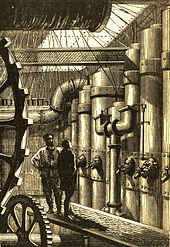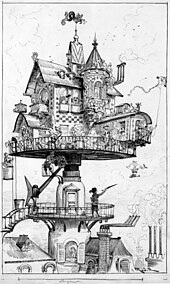Steampunk is a subgenre of science fiction that incorporates retrofuturistic technology and aesthetics inspired by 19th-century industrial steam-powered machinery.[1][2][3] Steampunk works are often set in an alternative history of the Victorian era or the American "Wild West," where steam power remains in mainstream use or in a fantasy world that similarly employs steam power.
Steampunk features anachronistic technologies or retrofuturistic inventions as people in the 19th century might have envisioned them — distinguishing it from Neo-Victorianism[4] — and is likewise rooted in the era's perspective on fashion, culture, architectural style, and art.[5] Such technologies may include fictional machines like those found in the works of H. G. Wells and Jules Verne.[6] Other examples of steampunk contain alternative-history-style presentations of such technology as steam cannons, lighter-than-air airships, analog computers, or such digital mechanical computers as Charles Babbage's Analytical Engine.[7][8]
Steampunk may also incorporate additional elements from the genres of fantasy, horror, historical fiction, alternate history, or other branches of speculative fiction, making it often a hybrid genre.[9] As a form of speculative fiction, it explores alternative futures or pasts but can also address real-world social issues.[10] The first known appearance of steampunk was in 1987, though it now retroactively refers to many works of fiction created as far back as the 1950s or earlier[11]. A popular subgenre is Japanese steampunk, consisting of steampunk-themed manga and anime,[12] with steampunk elements appearing in mainstream manga since the 1940s.[13]
Steampunk also refers to any of the artistic styles, clothing fashions, or subcultures that have developed from the aesthetics of steampunk fiction, Victorian-era fiction, art nouveau design, and films from the mid-20th century.[14] Various modern utilitarian objects have been modded by individual artisans into a pseudo-Victorian mechanical "steampunk" style, and several visual and musical artists have been described as steampunk.[15]



